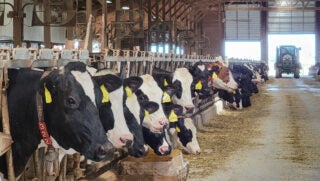Name the first thing that comes to mind when someone mentions Georgia agriculture … many of us would probably say peaches! But the Southern state is much more than that — contributing close to $74 billion each year to the state’s economy with a diverse farming portfolio from broilers and beef cattle to pecans, peanuts, and Vidalia Onions. In 2012, there were 42,257 farms in Georgia encompassing 9.6 million acres of land. One in seven Georgians works in agriculture, forestry, or a related field.
These impressive stats paint a much larger picture of the Georgia agriculture industry, but as one FFA chapter found out this past year sometimes seeing is believing when it comes to showcasing their state’s breadbasket.
“We wanted the nation to understand the diversity of agriculture that’s found within the state of Georgia and the economic impact we have as a state,” said Ashley Best, FFA Advisor at Winder-Barrow High School. “Also, it’s amazing that Georgia has been the top broiler producing state 25 years in a row.”
The Winder-Barrow FFA chapter represented Georgia in the 2016 National FFA Convention & Expo’s Hall of States display competition and beat out 33 other entries for the top award. The winning team included Mariah Lynn, Kerrigan Royster, Katie Sonntag, Triston Gable, Shelby Spears, Savannah Rutledge, Wyatt Tuggle, Shana Tuggle, Zoe Demos, Austin Barnes, and Sarah Lampp. The group also received support from the Georgia FFA Alumni, the Barrow County Farm Bureau, and the school administration.
“This has been a competition we have been trying to win for several years,” Best said. “Our students enjoy sharing their passion for agriculture to others and what better way than a creative exhibit over Georgia agriculture.”
The exhibit included information and facts about the top 10 Georgia commodities, including the farm gate value. The display also was home to an interactive game where visitors had to decide which region grows the most of each Georgia commodity. Best said the commodity word search — where visitors could use chalk to find words related to the booth – was the biggest hit. The chapter also gave away Georgia grown peanuts from the Georgia Farm Bureau and wooden ornaments that fellow FFA member Wyatt Ouzts made.
The students did have a few kinks to work out in putting together the award-winning display.
“The idea of a chicken coop was already in place from previous years, but the hard part was figuring out what to put in it. Our FFA had several committee meetings to decide exactly how we wanted it to look and the message we wanted to convey,” Best said. “Our students spent a lot of time researching each commodity to learn facts to teach to other FFA members. Once we had the idea, putting the whole thing together wasn’t too hard. However, logistics of travel with such a large exhibit was a challenge.”
In addition to the National FFA convention, the chapter displayed the exhibit at the Georgia State FFA Convention, allowing students from across the state the opportunity to visually learn about the economic impact the state of Georgia has in agriculture.
“We want our FFA members to know that agriculture is still the number one industry in the state,” Best said. “Our students gained a whole new respect for the agricultural industry in the state and took pride in teaching others from across the country. They improved their public speaking abilities and also learned valuable skills like teamwork that will benefit them in future careers and endeavors.”
Best recommends other FFA chapters across the country consider entering the Hall of States competition.
“Our FFA chapter really came together as a whole to make the exhibit happen. Each student on the Hall of States Committee had an important role and we relied on each other to complete the booth,” Best said. “Students gain ag knowledge and also have fun interacting with other FFA members from across the nation.”



